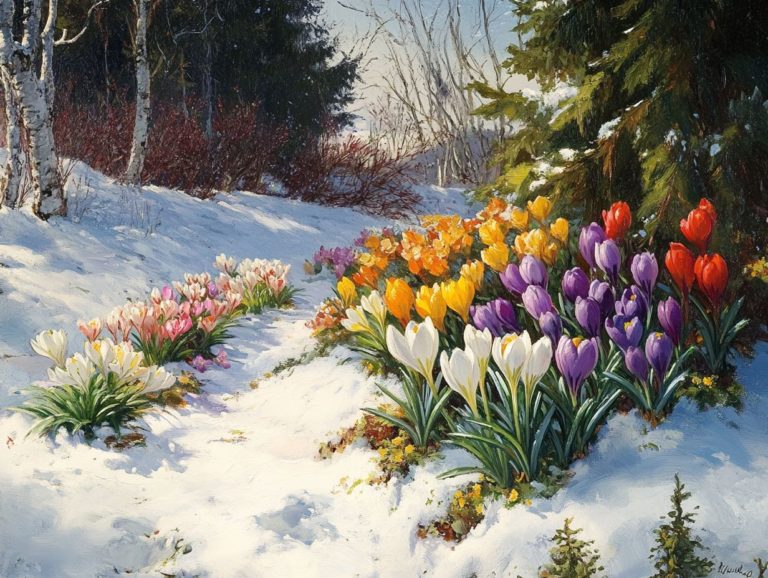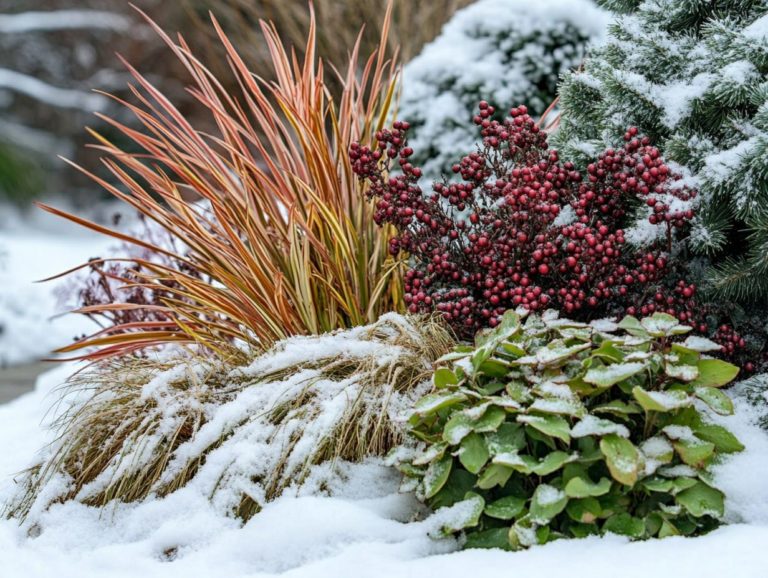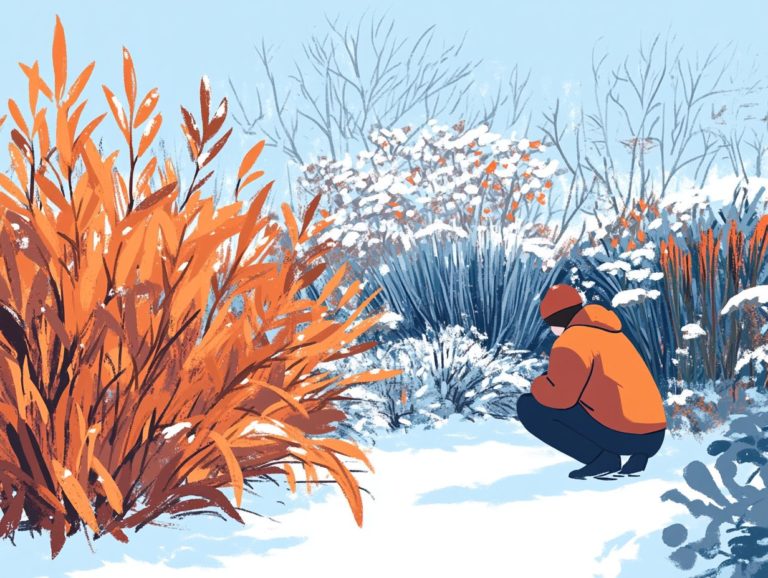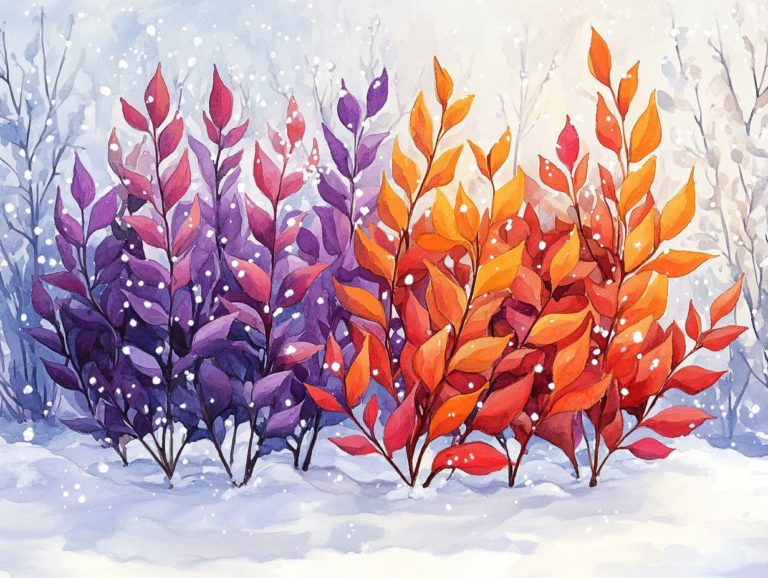Selecting Plants for Frost-Prone Areas
Want a thriving garden? Start by understanding what causes frost, the various types that can occur, and how to select the right vegetables and annuals. Frost can truly be a gardener s nemesis, especially in frost-prone areas where it tends to wreak havoc.
This guide will lead you through the process of choosing frost-tolerant plants, safeguarding your more sensitive varieties, and preparing your garden for the chill that winter brings.
You ll uncover techniques for creating microclimates and employing protective structures to ensure your plants thrive despite the drop in temperature. Whether you re an experienced gardener or just beginning your journey, this guide will equip you to tackle the challenges of gardening in frost-prone regions with confidence.
Contents
- Key Takeaways:
- Understanding Frost-Prone Areas
- Choosing Plants for Frost-Prone Areas
- Factors to Consider in Plant Selection
- Preparing Plants for Frost
- Long-Term Strategies for Frost Protection
- Frequently Asked Questions
- What are frost-prone areas?
- How do I know if my area is frost-prone?
- What types of plants are suitable for frost-prone areas?
- Can I grow delicate plants in frost-prone areas?
- What are some protective measures for my plants in frost-prone areas?
- Are there any plants that are not suitable for frost-prone areas?
Key Takeaways:
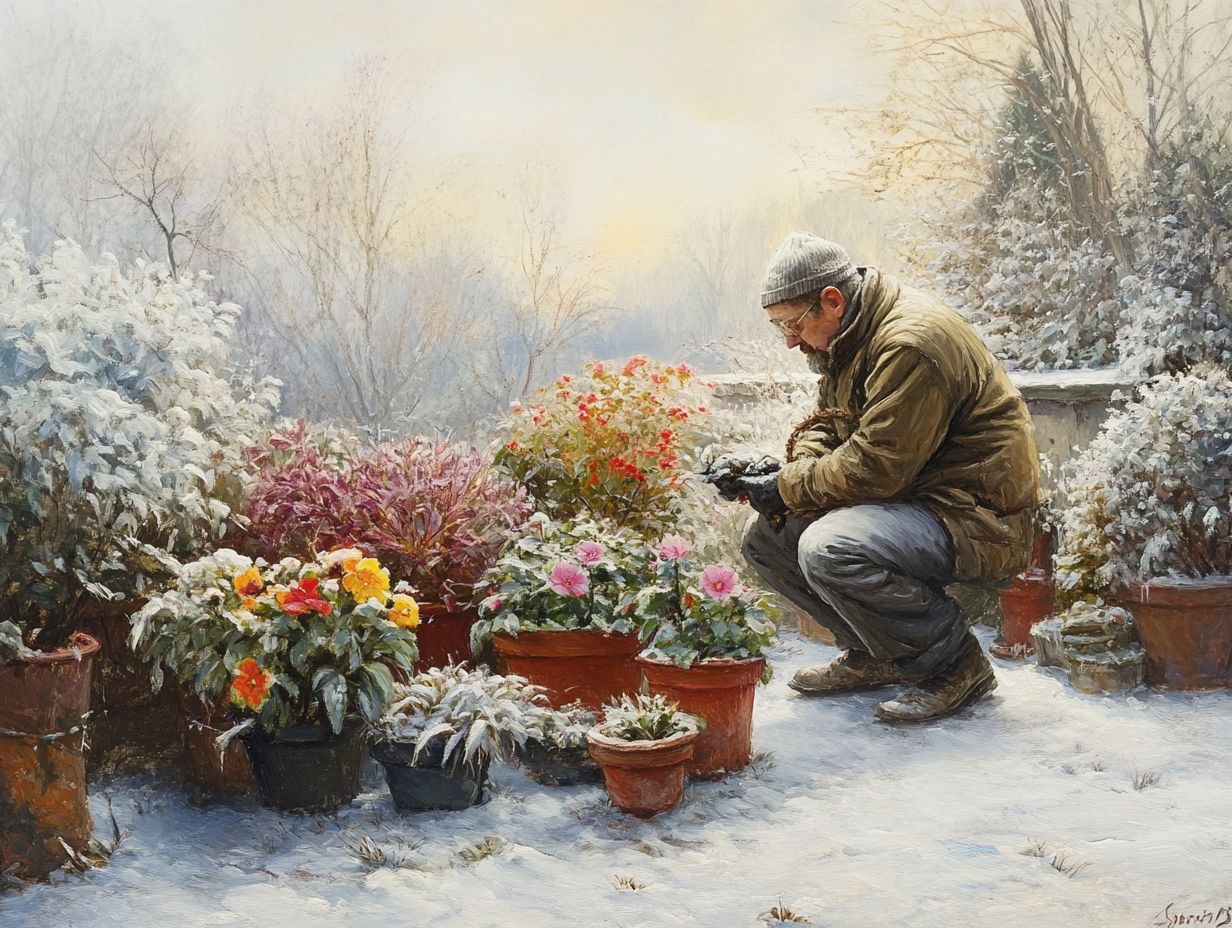
- Understanding the causes and types of frost is crucial in selecting plants for frost-prone areas.
- Frost-tolerant plants and protective measures can help prevent damage to sensitive plants.
- Consider factors like climate, hardiness zones (areas where certain plants can thrive based on climate), soil, and sunlight requirements when choosing plants.
Understanding Frost-Prone Areas
Understanding frost-prone areas is essential for your gardening success, especially if you find yourself in regions susceptible to low temperatures. For those in such areas, considering sustainable plant choices for cold climates can significantly impact plant growth and survival, particularly in frost pockets, those sneaky spots where cold air settles.
By familiarizing yourself with local frost dates and plant hardiness as outlined by the USDA, you must take action now to ensure your garden thrives in challenging climates, whether you re navigating the chill of North Dakota or the milder conditions of Arizona and Florida.
What Causes Frost?
Frost forms when temperatures dip below the freezing point, leading to the creation of ice crystals on surfaces, especially when there’s moisture in the soil. Understanding the conditions that foster frost, like clear skies and calm winds, is essential for safeguarding your vulnerable plants.
As temperatures plummet overnight, moisture in the air and soil begins to condense, resulting in dew that turns into ice crystals when it freezes. Humidity plays a pivotal role; higher humidity levels heighten the chances of frost forming, while drier conditions can help stave it off.
Maintaining adequate soil moisture sets the stage for frost development. To protect your plants from potential frost damage, consider using moisture sealants and covering plants with protective materials. These can create a protective barrier, minimizing the adverse effects of freezing temperatures while aiding in moisture retention during drier spells.
Types of Frost
You ll encounter various types of frost in your gardening endeavors, such as hoarfrost, radiation frost, and advective frost. Grasping these distinctions will enable you to implement effective freeze protection strategies tailored to the specific conditions you face.
For example, hoarfrost tends to form on clear, calm nights when humidity is high, enveloping your garden plants in a delicate layer of ice crystals. This can be particularly detrimental to tender young shoots, as the added weight of the frost can cause direct damage.
Radiation frost occurs when the ground loses heat rapidly, typically on still, clear nights, resulting in a significant drop in temperature. This type of frost can wreak havoc, especially on flowering plants that have already begun to bloom.
Advective frost arises from a mass of cold air moving into your area, posing a serious risk to entire crops.
To combat these frost threats, consider using cold frames, hoop tunnels, or frost blankets for essential insulation. Strategic planting of windbreaks can create a better microclimate that enhances plant survival.
Remember, taking proactive steps today can make all the difference for your garden tomorrow!
Choosing Plants for Frost-Prone Areas
Selecting the right plants for frost-prone areas is crucial for cultivating a flourishing garden. Boost your garden’s success by considering hardiness zones and enriching your soil with organic matter. For more insights, check out understanding plant selection for cold-climate design, which can help fortify its resilience against frost.
Frost-Tolerant Plants
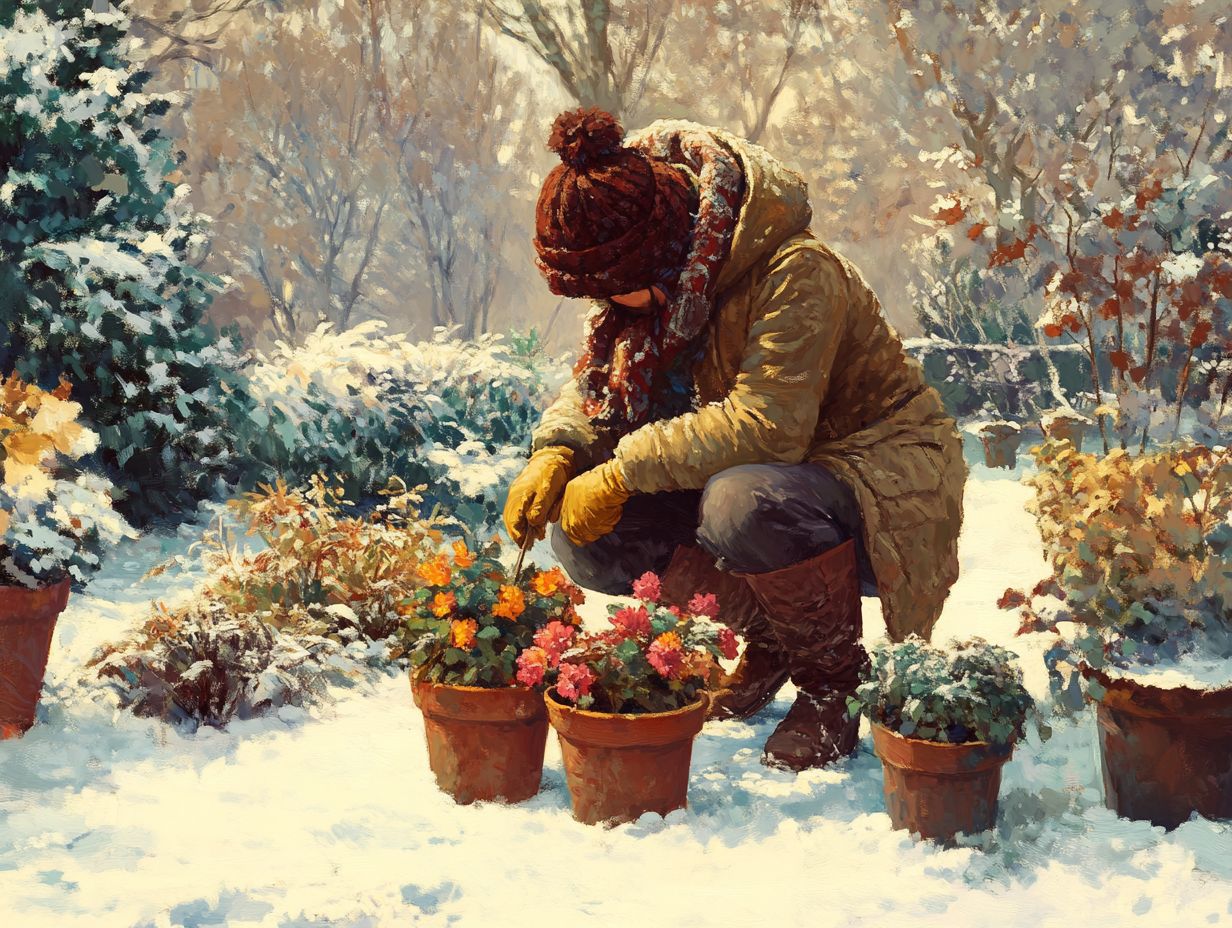
Frost-tolerant plants, including select annuals and perennials, can truly flourish in colder climates, infusing your garden with vibrant colors and textures all year round. By choosing these resilient plants, you not only elevate your garden s aesthetic but also protect it from the perils of frost damage.
Imagine incorporating hellebores, which bloom even under a blanket of snow, or sedums, celebrated for their robust trailing habits. With these choices, you can craft breathtaking landscapes that endure even the harshest conditions. Pansies and snapdragons are fantastic additions too, bringing immediate bursts of color as you plant them in early spring perfect for that instant gratification after winter s departure.
To maximize the success of these hardy varieties, it’s essential to understand the unique needs of frost-prone areas, including soil moisture. Act now to improve soil drainage and protect your garden from frost damage! Paying attention to mulch can significantly enhance your garden s fortitude, ensuring it remains vibrant and inviting throughout the colder months.
Protecting Sensitive Plants
Protecting your sensitive plants from frost requires active steps. Consider using coverings, cold frames, or hoop tunnels to create a protective barrier against those icy temperatures. Employing these strategies can significantly boost the chances of your garden plants thriving through those chilly nights.
Choosing the right materials is key for effective freeze protection and ensuring your hardy plants are prepared for frost. Lightweight row covers made of spun polyester or frost cloth can insulate your plants while still allowing sunlight to filter through, ensuring they get the light they need.
You can also craft cold frames from old windows to trap heat and shield seedlings from harsh elements. Hoop tunnels, built with PVC pipes or metal hoops covered in clear plastic, create a greenhouse effect that can significantly raise temperature and humidity levels.
By combining these techniques, such as using crop insurance and protective barriers, you can effectively safeguard your delicate flora against the damaging effects of frost.
Factors to Consider in Plant Selection
When selecting plants for your garden, it’s essential to consider several factors, such as the local climate, hardiness zones, and the specific moisture and sunlight requirements of each plant.
By understanding these elements, including weather forecasts, you can craft a planting calendar that aligns with seasonal shifts, ensuring optimal growth and vibrancy in your garden.
Climate and Hardiness Zones
Climate is pivotal in determining which plants can thrive in specific hardiness zones, as outlined by the USDA. By understanding these zones, you can select plants that are perfectly suited for your local climate, ultimately enhancing your garden’s resilience.
The USDA Hardiness Zone Map is an invaluable resource for both novice and seasoned horticulturists, dividing the United States into distinct areas based on average winter temperatures and the specific zones applicable for plants like Geranium, Rozanne and Campanula lactiflora. These zones, ranging from Zone 1 the coldest to Zone 13 the warmest offer critical insight into the types of flora that can sustainably flourish in your region.
By aligning your plant selection with these zones, you ensure optimal growth while also boosting the overall health and longevity of your garden. This thoughtful selection process not only mitigates risks associated with unpredictable weather but also leads to a more successful and vibrant landscape.
Soil and Sunlight Requirements
The soil and sunlight requirements of your garden plants are critical factors that determine their growth and health. Ensure your plants have enough moisture and sunlight to significantly enhance their resilience, especially in areas prone to frost.
Different soil types like sandy, clay, and loamy each possess unique moisture retention capabilities that affect how well your plants can absorb water. For instance, sandy soil drains quickly and holds less moisture. This makes it ideal for tropical plants and drought-resistant plants. In contrast, clay soil retains water but can become compacted, potentially hindering root systems.
Understanding sunlight needs is equally essential. Full-sun plants thrive with at least six hours of sunlight daily, while shade-loving plants flourish in areas with limited exposure. This is crucial for popular varieties like Achillea chrysocoma and Cirsium rivulare. Choose the right soil and light to make your garden thrive!
Preparing Plants for Frost

Preparing your plants for the impending frost requires essential practices, including pruning, mulching, and hardening them off. Getting plants used to outdoor conditions gradually helps ensure they are robust enough to withstand chilling temperatures.
Implementing these preventative measures can significantly reduce frost damage in your garden. This allows it to thrive even in the cold. For example, incorporating hardy annuals can be beneficial.
Pruning and Mulching
Pruning and mulching are essential gardening techniques. They help you maintain soil moisture and enhance plant health, especially as you prepare for frost. These techniques can also support vegetable planting during cooler months.
By strategically cutting back overgrown branches and removing any dead or diseased wood, such as Achillea chrysocoma, you encourage better air circulation and stimulate new growth in your plants. Meanwhile, applying a thick layer of organic mulch acts as a protective barrier. It insulates the soil and minimizes temperature fluctuations. This is particularly useful for tropical plants that require extra care, especially as temperatures drop.
Employing the right mulching technique and timely pruning before the first frost can significantly enhance your plants’ resilience. This way, they ll be better equipped to weather the winter months and emerge with robust health come spring, even in regions like North Dakota.
Long-Term Strategies for Frost Protection
Implementing long-term strategies for frost protection is crucial for cultivating a flourishing garden, especially in frost-prone regions such as Florida or Arizona. Creating small climate areas and utilizing protective structures, like cold frames and hoop tunnels, effectively shields your delicate plants from the harsh impacts of frost and frigid temperatures. This enhances the growth of plants like Geranium Rozanne.
This thoughtful approach will ensure your garden thrives, even in the face of chilly challenges.
Creating Microclimates
Creating microclimates in your garden can significantly protect your sensitive plants from frost. By placing structures strategically and using the natural landscape, you can create warmer pockets that shield your plants from extreme cold.
Try different techniques to achieve this. Position windbreaks, plant on slopes, or use reflective surfaces to capture sunlight. This is especially beneficial for growing Campanula lactiflora, a flowering plant that thrives in warmer conditions.
These microclimates not only protect your flora from frost but also extend your growing season. Enjoy the creative freedom to blend natural strategies with artificial elements, customizing environments to fit your unique landscape.
Using Protective Structures
Protective structures like cold frames and hoop tunnels insulate plants from frost. They help extend your garden’s growing season by creating a barrier against freezing temperatures while still allowing sunlight in.
These structures provide shelter for delicate seedlings and create a consistent environment for vegetables like tomatoes and peppers. Cold frames, made from wood and glass or plastic, create a mini-greenhouse effect that retains warmth.
Hoop tunnels, made from flexible piping covered with plastic or fabric, are great for larger areas. Both systems promote faster growth and higher yields, making them invaluable for gardeners eager to enhance their harvests.
Frequently Asked Questions
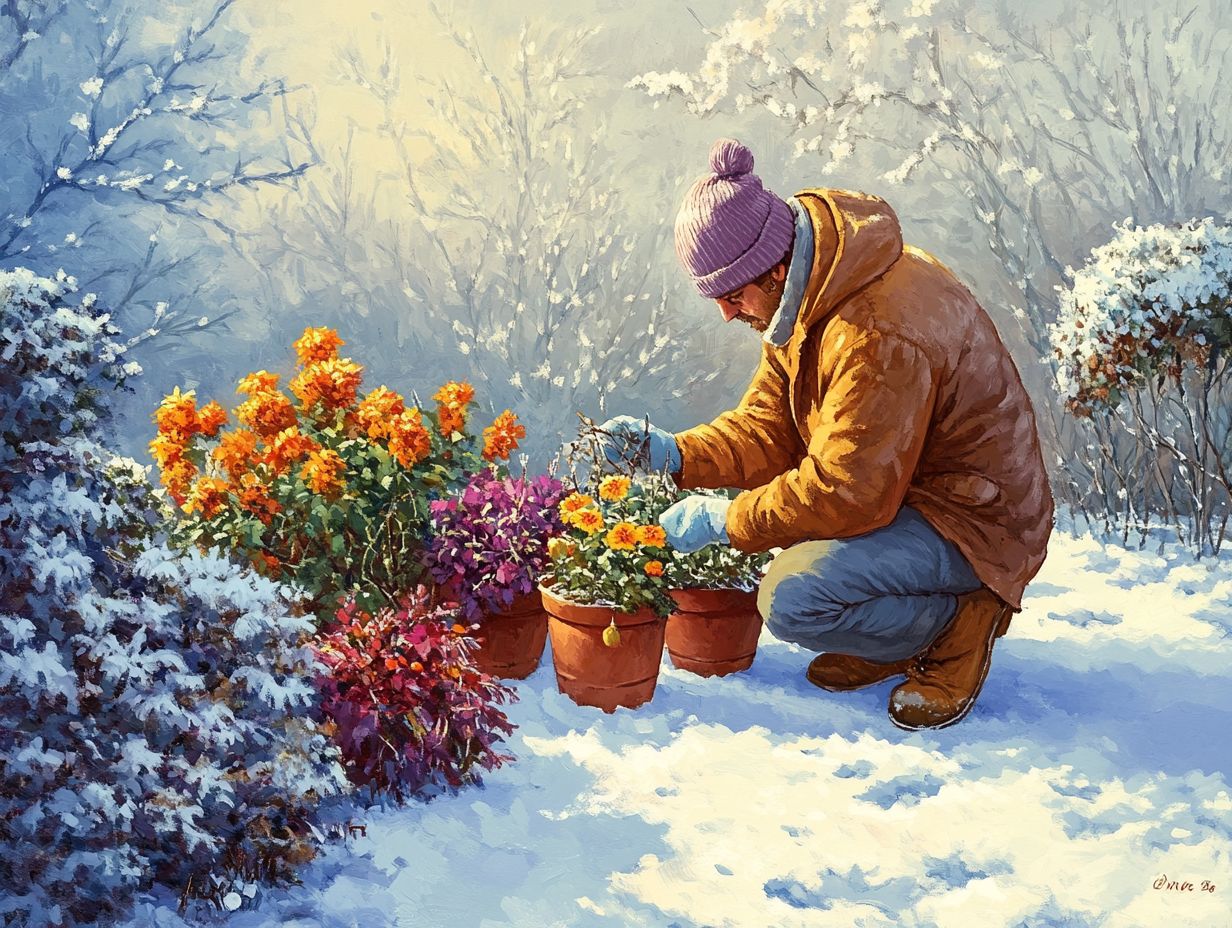
What are frost-prone areas?
Frost-prone areas are places that are likely to experience freezing temperatures. Understanding selecting plants for a winter garden is crucial, as these conditions can damage plants.
How do I know if my area is frost-prone?
Check if your area has cold temperatures and freezing weather in winter. Your local gardening or agricultural extension office can provide more specific information.
What types of plants are suitable for frost-prone areas?
Plants that thrive in cold climates, like evergreens and hardy perennials, are perfect for frost-prone areas. For those looking to enhance their gardens, selecting plants for shade in cold climates can ensure they survive freezing temperatures.
Can I grow delicate plants in frost-prone areas?
It s best not to grow delicate plants in these areas, as they are more vulnerable to frost damage. However, using microclimates or protective measures can help them survive.
What are some protective measures for my plants in frost-prone areas?
To protect your plants, cover them with mulch or blankets, use frost cloths, and provide extra insulation with straw or leaves. These steps are crucial for safeguarding even tropical plants from unexpected frost.
Planting in sheltered areas or near structures can also help shield plants from harsh winds.
Are there any plants that are not suitable for frost-prone areas?
Avoid planting tropical or subtropical plants in frost-prone areas, as they usually cannot survive freezing conditions. Instead, consider selecting trees for cold-climate landscaping to ensure your garden thrives.


